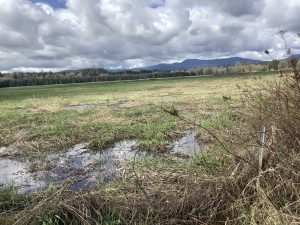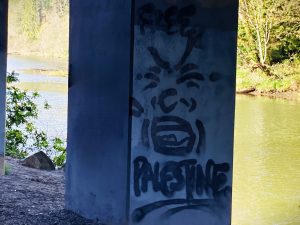“The first thing you need to know. People hold the fate of Adams garden in their hands”, so said our tour guide.

A drive through rural Thurston County took us past wet meadows, grazed fields, some ‘overgrown swamps’. At several stops, a verdant green landscape of grass and wetlands stretched to the distant hills under billowing clouds in a deep blue sky. The sky and clouds reflected in the ponded water. A walk along this road, somehow built across a marsh, revealed jelly-like translucent circles the size of dinner plates floating in knee-deep water. They held possibly up to 600 eggs of the Red-legged frog, a relatively common frog that also needs extensive upland woodlands to persist. But look. Further out. In ankle deep impossibly shallow water were different egg mass jellies. These belonged to our local endangered frog, the Oregon Spotted Frog (OSF). Rana pretiosa, meaning “precious pretty frog” previously could be found in California and much of western Oregon and Washington, but now it survives in only a few counties of the Pacific Northwest. It has been listed as a federally endangered species since 2014 when it was determined that the species had been lost from over 90% of its former range. It once occurred in extensive meadows near Lake Washington, lowland Kent Valley, and Monroe.
Biologists have found some of their breeding locations by stumbling through wet hardhack or across grassy hummoky meadows in mid February. They found a dozen breeding sites along connected wetlands and marshes in the Black River watershed. I was told these frogs sometimes even co-occur with Washington’s only endemic fish, the Olympic mudminnow. Endemic means ‘it only occurs here, ever’. Both these aquatic species likely occurred since the glaciers receded. Now, the daunting challenge is puzzling out how these extremely rare aquatic species can survive the next 20 years. The good news is that humans and these water dependent species can co-exist with thoughtful care and consideration of the frog’s life cycle.
Life Cycle of the Oregon Spotted Frog
Around Presidents Day, adult male frogs start their mating call…light drumming vaguely resembling a distant woodpecker. Female OSF lay their eggs in “warm” (~10 celsius) ankle deep water or on floating hummocks in flooded fields or marshes with grasses, sedges and rush, sometimes tucked up under willow. They are quite ‘traditional’ locations. Frogs often return to the same location every year. If they can. If water levels are ‘ok’. And if the shallows persist, eggs develop into larvae. And, in turn, into tadpoles, which graze on algae or diatoms and develop lungs into little frogs sometimes as late as early August. While the tadpoles develop into small frogs (by early August), their parents may remain near the breeding marsh or go for adventures. I’m told they’ve been known to move up to 3 miles through the shallow waters of old ditches, marshes and wetlands to find their equally traditional non-breeding summer or winter habitat, rarely leaving the water and only for short duration. It is unknown how many of the juvenile metamorphs survive the 2-3 years to mature into breeding frogs as they confront a variety of predators that includes garter snakes and herons, higher flows, warm water fish and the bullfrog, which pose serious threats to OSF populations.
But the math is fun. One could ‘estimate’ population ‘viability’ I’m told. It is actually rarely measured: Say 50 females (each with up to ~600 eggs) deposit egg masses in one location. So 30,000 embryos with the spark of life hatch into young larvae. If water levels are suitable, up to 1% of those become small frogs. 300 small frogs with lungs and webbed feet survive. Of those, so few reach adulthood. If the water has persisted and the frogs were not eaten, these youngsters may reach adulthood. Where do they go?
I learned I won’t see them on my doorframe, like our local tree frogs that call each spring. They are in the marshes, quiet and often unseen. Long extensive marshes, sometimes maintained by beaver activity. In unaltered landscapes, beaver activity can maintain shallow water through summer, so important for their life history.
No one is quite sure why they are where they are. Marshy areas occur throughout much of the Chehalis Basin, but most of these frogs occur here, in Thurston County. My driving tour guide, Bonnie, said her thesis work suggested that the local frogs may occupy a narrow band that could have been inundated by a late glacial outburst flood, but that is one of many unexplained mysteries. Before European settlement, the frogs likely depended on extensive engineering by beavers across lowland Pacific Northwest. Beavers harnessed the water and engineered moist meadows adjoining their deeper ponds – swimways (She’s fallen into 4’ deep beaver carved ‘canals’ across these extensive meadows). Since deglaciation, fertile soil accumulated in many of these lowland meadows, fertile enough for tons of hay per acre or lush grasses for grazing. Early settlers tried to reclaim lush wetland soil from the the high water tables of the marshland. In some cases, enough ‘dry land’ was reclaimed to raise cattle or hay on the fertile soil that developed under the marsh, or to even build a house on a rise. Early laws and some current plans support ‘reclaiming’ prime soils. But ‘reclaiming land’ often involved removing the beaver and creating a human-made canal through high water areas to attempt to reduce water levels in adjoining marshes. This tradition of farming can affect wildlife. And the frogs seem to persist only where this traditional land-reclaiming ditching activity is rarely done, and where some water is shared with the frogs. Bonnie’s thesis, based on older information, suggests that a very large fraction of the OSF’s marshes remain overgrown. Sometimes saving a marsh is a difficult tradeoff because it may mean the final hay cannot be cut. But grazing or haying the margins of this area in late summer can benefit both farmer and frog.
How Humans and OSF can Coexist
In some places where this frog persists, blueberries are sometimes sold, late season grazing occurs and hay is harvested in the margins of the shallow areas. In fall, willow stakes are cut to replant for salmon restoration in winter.
The first thing you need to know is those who host the frog on their land are heroic. They allow areas flooded for eons to continue to benefit wildlife and humans. These areas slow downstream flooding, host waterfowl, salmon, mudminnows, and frogs.
Can we support a farming ‘industry’ that also supports wildlife? It’s a decision made by landowners and by some regulations. Can regulators and county assessors help the rare wildlife? It makes a lot of sense to me to find ways to support homeowners who host wildlife on their land.
We seem to know what the frogs need – stable water conditions during key life stages and extensive flooded flats. And they occur where they occur. Water levels are not just dependent on rain and snow. Land management also maintains habitat. Relocating frogs to new uninhabited sites as mitigation for destroying their traditional breeding places rarely works, notwithstanding heroic efforts.
These extremely rare traditional sites need to be protected, which may mean:
- researching the very specific water levels they have adapted to and the actual ‘disturbance history’ whether natural or manmade;
- completely avoiding entry into a given drainage, leaving OSF habitat undisturbed; and
- helping homeowners who built where the groundwater was too high.
And we just do not know what the climate holds. Both unusual rain-on-snow events and drought highly affect this frog that barely holds on in so few places.
I understand that Tumwater is developing the Bush Prairie Habitat Conservation Plan. This HCP was developed to streamline the process of obtaining an Incidental Take Permit which would allow development that does not, at the same time, impair the recovery of 4 endangered species. That is my understanding at least.
I hope Tumwater and Thurston County ensure its HCP complies with the intent of the Endangered Species Act. We can always build another house or reclaim land, but we’ll never recreate the Creation. Humans have flown to the moon. We can keep another species alive. We have choices. Difficult choices. We finished the tour singing the ‘First thing you know’ a Lee Marvin song, that waxes long on just where the pretty things grow.
Esther Kronenberg is a member of the Clean Black Lake Alliance

Be First to Comment